
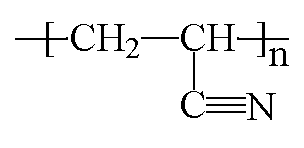
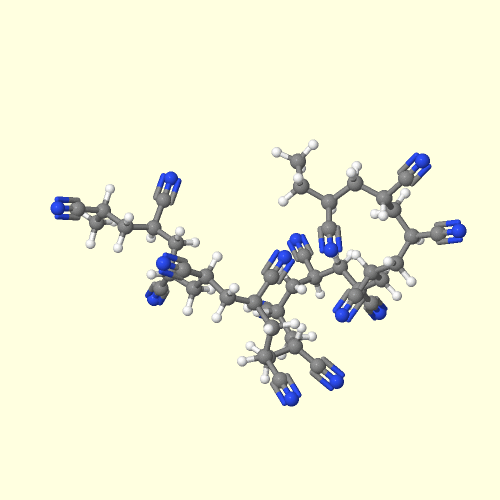
The model on the right above is an image of the pdb model you can view by clicking here or you can just click on the image itself.
Either way, be sure to close the new window that opens up with the 3D model in it when you are ready to come back here.
For polyacrylonitrile at a glance, click here!
Polyacrylonitrile is used for very few products an average consumer would be familiar with, except to
make another polymer, carbon fiber. Homopolymers of polyacrylonitrile have been uses as fibers in hot gas filtration systems, outdoor awnings, sails for yachts, and even fiber reinforced concrete.
But mostly copolymers containing
polyacrylonitrile are used as fibers to
make knitted clothing, like socks and sweaters, as well as outdoor products like tents
and such. If the label of some piece of clothing says "acrylic", then
it's made out of some copolymer of polyacrylonitrile. Usually they're
copolymers of acrylonitrile and methyl acrylate, or acrylonitrile
and
methyl methacrylate:
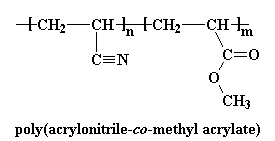
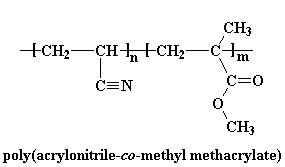
Also, sometimes we make copolymers of acrylonitrile and vinyl chloride. These copolymers are flame-retardant,
and the fibers made from them are called modacrylic fibers.
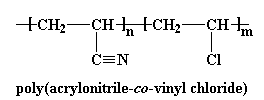
But the slew of copolymers of acrylonitrile doesn't stop there.
Poly(styrene-co-acrylonitrile) (SAN) and
poly(acrylonitrile-co-butadiene-co--styrene)
(ABS), are used as plastics.
 SAN is a simple random copolymer of styrene and acrylonitrile. But ABS is
more complicated. It's made by polymerizing styrene and acrylonitrile in
the presence of polybutadiene. Polybutadiene has carbon-carbon
double bonds in it, which can polymerize, too. So we end up with a
polybutadiene chain with SAN chains grafted onto it, like you see below.
SAN is a simple random copolymer of styrene and acrylonitrile. But ABS is
more complicated. It's made by polymerizing styrene and acrylonitrile in
the presence of polybutadiene. Polybutadiene has carbon-carbon
double bonds in it, which can polymerize, too. So we end up with a
polybutadiene chain with SAN chains grafted onto it, like you see below.

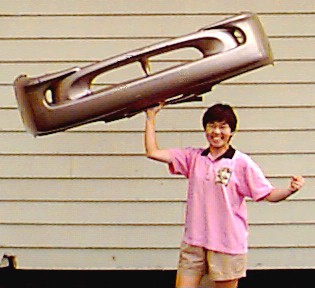 ABS is very strong and lightweight. It is strong enough to be used to
make automobile body parts, but it is so light that Wassana can lift this
front bumper fascia over her head with only hand! Using plastics like ABS
makes automobiles lighter, so they use less fuel, and therefore they
pollute less.
ABS is very strong and lightweight. It is strong enough to be used to
make automobile body parts, but it is so light that Wassana can lift this
front bumper fascia over her head with only hand! Using plastics like ABS
makes automobiles lighter, so they use less fuel, and therefore they
pollute less.
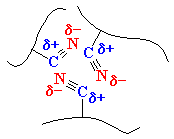 ABS is a stronger plastic than polystyrene
because of the nitrile groups of its acrylonitrile units. The
nitrile groups are very polar, so they are attracted to each other. This
allows opposite charges on the nitrile groups to stabilize each other
like you see in the picture on the left. This strong attraction holds ABS
chains together tightly, making the material stronger. Also the rubbery
polybutadiene makes ABS tougher than polystyrene.
ABS is a stronger plastic than polystyrene
because of the nitrile groups of its acrylonitrile units. The
nitrile groups are very polar, so they are attracted to each other. This
allows opposite charges on the nitrile groups to stabilize each other
like you see in the picture on the left. This strong attraction holds ABS
chains together tightly, making the material stronger. Also the rubbery
polybutadiene makes ABS tougher than polystyrene.
Polyacrylonitrile is a vinyl polymer, and a
derivative of
the acrylate family of polymers. It is made
from the monomer acrylonitrile by free radical
vinyl polymerization.

This is what the monomer acrylonitrile really looks like:
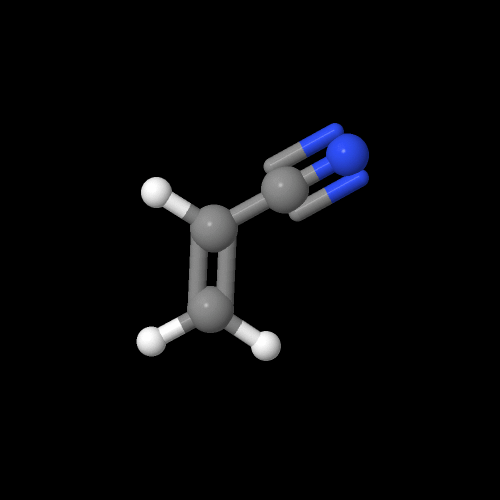
The model on the right above is an image of the pdb model you can view by clicking here or you can just click on the image itself.
Either way, be sure to close the new window that opens up with the 3D model in it when you are ready to come back here.
Other polymers that are used as fibers include:









 ABS is very strong and lightweight. It is strong enough to be used to
make automobile body parts, but it is so light that Wassana can lift this
front bumper fascia over her head with only hand! Using plastics like ABS
makes automobiles lighter, so they use less fuel, and therefore they
pollute less.
ABS is very strong and lightweight. It is strong enough to be used to
make automobile body parts, but it is so light that Wassana can lift this
front bumper fascia over her head with only hand! Using plastics like ABS
makes automobiles lighter, so they use less fuel, and therefore they
pollute less.
 ABS is a stronger plastic than polystyrene
because of the nitrile groups of its acrylonitrile units. The
nitrile groups are very polar, so they are attracted to each other. This
allows opposite charges on the nitrile groups to stabilize each other
like you see in the picture on the left. This strong attraction holds ABS
chains together tightly, making the material stronger. Also the rubbery
polybutadiene makes ABS tougher than polystyrene.
ABS is a stronger plastic than polystyrene
because of the nitrile groups of its acrylonitrile units. The
nitrile groups are very polar, so they are attracted to each other. This
allows opposite charges on the nitrile groups to stabilize each other
like you see in the picture on the left. This strong attraction holds ABS
chains together tightly, making the material stronger. Also the rubbery
polybutadiene makes ABS tougher than polystyrene.




